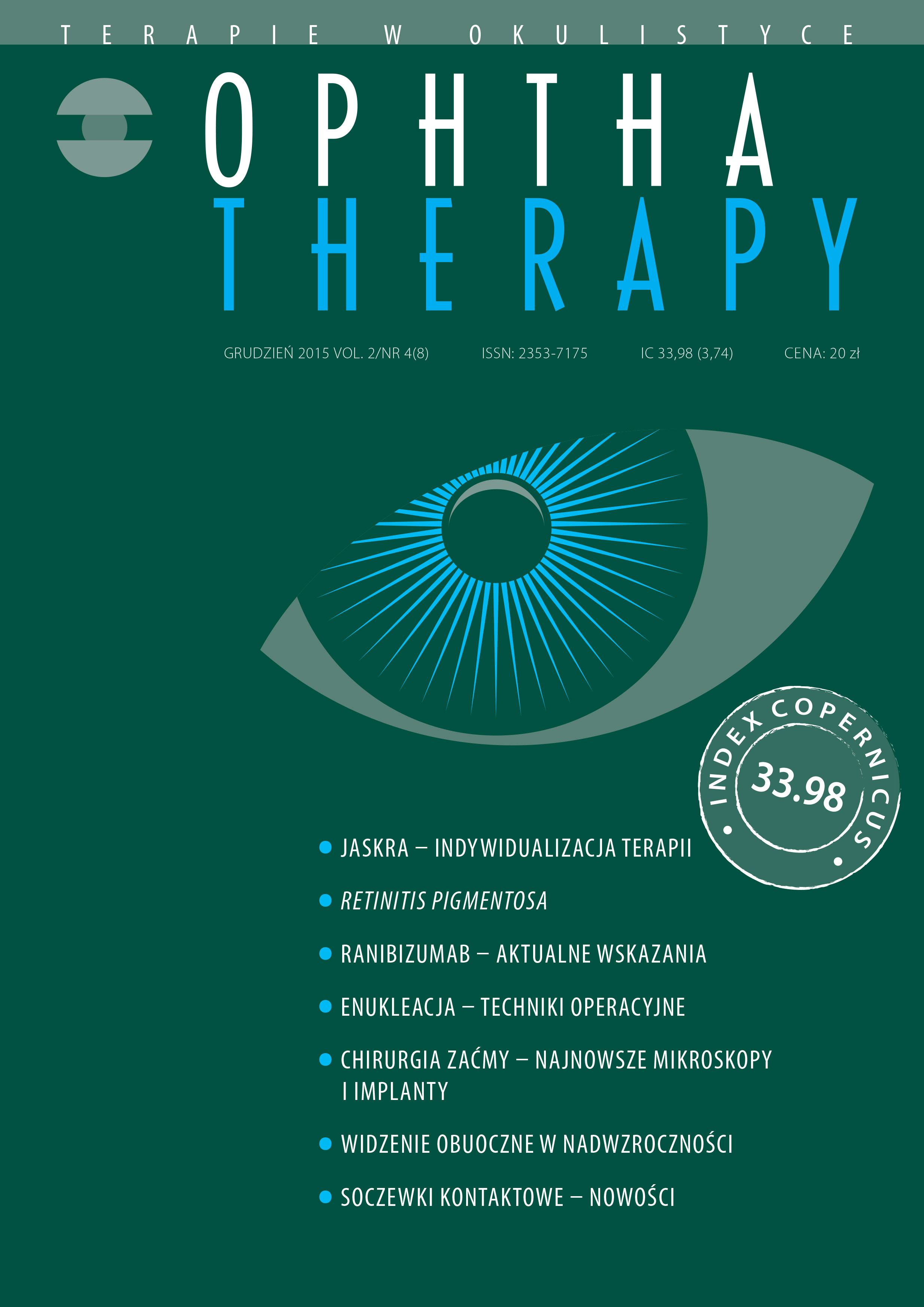Doszklistkowe iniekcje ranibizumabu w terapii cukrzycowego obrzęku plamki
##plugins.themes.bootstrap3.article.main##
Abstrakt
Cukrzycowy obrzęk plamki jest główną przyczyną pogorszenia widzenia u chorych na cukrzycę. Jego patogeneza wydaje się wieloczynnikowa. Obecnie zastosowanie w jego leczeniu znajdują m.in.: laseroterapia, doszklistkowa terapia anty-VEGF oraz glikokortykosteroidoterapia. W niniejszej pracy przedstawiono najnowsze wyniki badań dotyczących skuteczności doszklistkowych iniekcji ranibizumabu jako terapii, która zrewolucjonizowała leczenie cukrzycowego obrzęku plamki.
Pobrania
##plugins.themes.bootstrap3.article.details##

Utwór dostępny jest na licencji Creative Commons Uznanie autorstwa – Użycie niekomercyjne – Bez utworów zależnych 4.0 Międzynarodowe.
Copyright: ? Medical Education sp. z o.o. License allowing third parties to copy and redistribute the material in any medium or format and to remix, transform, and build upon the material, provided the original work is properly cited and states its license.
Address reprint requests to: Medical Education, Marcin Kuźma (marcin.kuzma@mededu.pl)
Bibliografia
2. Zasady postępowania w cukrzycowym obrzęku plamki. Wytyczne Polskiego Towarzystwa Okulistycznego 2014.
3. Rotsos TG, Moschos MM. Cystoid macular edema. Journal of Clinical Ophthalmology. 2008; 2(4): 919-30.
4. Bhagat N, Grigorian RA, Tutela A et al. Diabetic macular edema: pathogenesis and treatment. Survey of Ophthalmology. 2009; 54(1): 1-32.
5. Early Treatment Diabetic Retinopathy Study Research Group. Photocoagulation for diabetic macular edema. EDTRS report number 1. Arch Ophthalmol. 1985; 103(12): 1796-806.
6. Schmidt-Erfurth U, Lang GE, Holz FG et al.; RESTORE Extension Study Group. Three-year outcomes of individualized ranibizumab treatment in patients with diabetic macular edema: the RESTORE extension study. Ophthalmology. 2014; 121(5): 1045-53.
7. Zhang Y, Yao Z, Kaila N et al. Pharmacokinetics of Ranibizumab after Intravitreal Administration in Patients with Retinal Vein Occlusion or Diabetic Macular Edema. Ophthalmology. 2014; 121(11): 2237-46.
8. Elman MJ, Bressler NM, Qin H et al. Expanded 2-year follow-up of ranibizumab plus prompt or deferred laser or triamcinolone plus prompt laser for diabetic macular edema. Ophthalmology. 2011; 118(4): 609-14.
9. Nguyen QD, Brown DM, Marcus DM et al; on behalf of the RISE and RIDE Research Group. Ranibizumab for diabetic macular edema: results from 2 phase III randomized trials: RISE and RIDE. Ophthalmology. 2012; 119(4): 789-801.
10. Brown DM, Nguyen QD, Marcus DM et al; on behalf of the RIDE and RISE Research Group. Long-term outcomes of ranibizumab therapy for diabetic macular edema: the 36-month results from two phase III trials: RISE and RIDE. Ophthalmology. 2013; 120(10): 2013-22.
11. Nguyen QD, Shah SM, Khwaja AA et al.; READ-2 Study Group. Two-year outcomes of the ranibizumab for edema of the mAcula in Diabetes (READ-2) study. Ophthalmology. 2010; 117(11): 2146-51.
12. Massin P, Bandello F, Garweg JG et al. Safety and efficacy of ranibizumab in diabetic macular edema (RESOLVE Study): a 12-month, randomized, controlled, double-masked, multicenter phase II study. Diabetes Care. 2010; 33(11): 2399-405.
13. Mitchell P, Bandello F, Schmidt-Erfurth U et al; on behalf of the RESTORE Study Group. The RESTORE study: ranibizumab monotherapy or combined with laser versus laser monotherapy for diabetic macular edema. Ophthalmology. 2011; 118: 615-25.
14. Domalpally A, Ip MS, Ehrlich JS. Effects of intravitreal ranibizumab on retinal hard exudate in diabetic macular edema: findings from the RIDE and RISE phase III clinical trials. Ophthalmology. 2015; 122(4): 779-86.
15. Boyer DS, Nguyen QD, Brown DM et al. RIDE and RISE Research Group Outcomes with As-Needed Ranibizumab after Initial Monthly Therapy: Long-Term Outcomes of the Phase III RIDE and RISE Trials. Ophthalmology. 2015 Oct 6. pii: S0161-6420(15)00783-6.
16. Pearce I, Banerjee S, Burton BJ et al.; RELIGHT Study Group. Ranibizumab 0.5 mg for Diabetic Macular Edema with Bimonthly Monitoring after a Phase of Initial Treatment: 18-Month, Multicenter, Phase IIIB RELIGHT Study. Ophthalmology. 2015; 122(9): 1811-9.
17. Sadiq MA, Soliman MK, Sarwar S et al; READ-3 Study Group. Effect of Vitreomacular Adhesion on Treatment Outcomes in the Ranibizumab for Edema of the Macula in Diabetes (READ-3) Study. Ophthalmology. 2015 Oct 28. pii: S0161 6420(15)01110-0 [epub ahead of print].
18. Ishibashi T, Li X, Koh A et al.; REVEAL Study Group. The REVEAL Study: Ranibizumab Monotherapy or Combined with Laser versus Laser Monotherapy in Asian Patients with Diabetic Macular Edema. Ophthalmology. 2015; 122(7): 1402-15.

